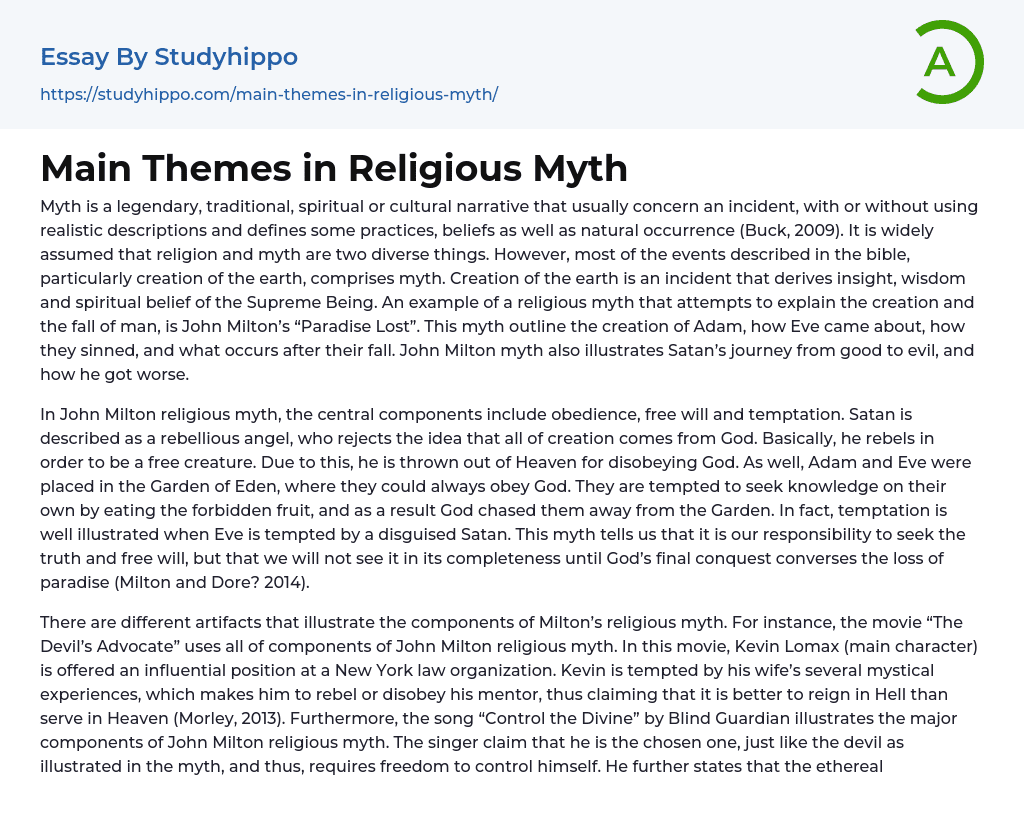Myth is a legendary, traditional, spiritual or cultural narrative that usually concern an incident, with or without using realistic descriptions and defines some practices, beliefs as well as natural occurrence (Buck, 2009). It is widely assumed that religion and myth are two diverse things. However, most of the events described in the bible, particularly creation of the earth, comprises myth. Creation of the earth is an incident that derives insight, wisdom and spiritual belief of the Supreme Being. An example of a religious myth that attempts to explain the creation and the fall of man, is John Milton’s “Paradise Lost”. This myth outline the creation of Adam, how Eve came about, how they sinned, and what occurs after their fall. John Milton myth also illustrates Satan’s journey from g
...ood to evil, and how he got worse.
In John Milton religious myth, the central components include obedience, free will and temptation. Satan is described as a rebellious angel, who rejects the idea that all of creation comes from God. Basically, he rebels in order to be a free creature. Due to this, he is thrown out of Heaven for disobeying God. As well, Adam and Eve were placed in the Garden of Eden, where they could always obey God. They are tempted to seek knowledge on their own by eating the forbidden fruit, and as a result God chased them away from the Garden. In fact, temptation is well illustrated when Eve is tempted by a disguised Satan. This myth tells us that it is our responsibility to seek the truth and free will, but that we will not see it in its completeness until God’s final
conquest converses the loss of paradise (Milton and Dore? 2014).
There are different artifacts that illustrate the components of Milton’s religious myth. For instance, the movie “The Devil’s Advocate” uses all of components of John Milton religious myth. In this movie, Kevin Lomax (main character) is offered an influential position at a New York law organization. Kevin is tempted by his wife’s several mystical experiences, which makes him to rebel or disobey his mentor, thus claiming that it is better to reign in Hell than serve in Heaven (Morley, 2013). Furthermore, the song “Control the Divine” by Blind Guardian illustrates the major components of John Milton religious myth. The singer claim that he is the chosen one, just like the devil as illustrated in the myth, and thus, requires freedom to control himself. He further states that the ethereal sons should now disobey, arise and be free because they are bound to no laws(Milton and Dore? 2014).
The mythical patterns of events is attractive to contemporary audiences. This is because, the interaction between movie and myth can be perceived as one of the forces which contributes to religion growth in the United States. The key to recognizing religion is to watch movies and listening to songs that emerge from long exposure of religious events (Lyden, 2003). Many people feels that any person existing in this world live by what they believe. As the audience, people feel that it is important to interpret an event in accordance to their own imagination, belief and experience.
By watching movies where the presence of religious myth is the plot, I feel an achievement in understanding the importance of obedience, free will and
how I must overcome temptation. In fact, after watching, I usually walk away thinking of the temptations the individual experienced and the difficulties they encountered in pursuit of freedom. However, there are times when I have decided to seek knowledge on my own and watching such a movie makes me to learn a lot about believing in God. At the moment as well as in the future, a good play that may have the same religious myth will be of great importance and consideration.
References
- Buck, C. (2009). Religious myths and visions of America: How minority faiths redefined
America's world role. Westport, Conn: Praeger. - Lyden, J. C. (2003). Film as religion: Myths, morals, and rituals. New York u.a.: New York
Univ. Press. - Milton, J., & Dore?, G. (2014). Milton's Paradise lost.
- Morley, I. (2013). The devil's advocate.
- Creation Myth essays
- Creation Vs Evolution essays
- Achilles essays
- Apollo essays
- Gilgamesh essays
- Hercules essays
- Iliad essays
- Myths essays
- Odysseus essays
- Oedipus essays
- Trojan War essays
- Zeus essays
- 1984 essays
- A Farewell to Arms essays
- A Good Man Is Hard to Find essays
- A Hanging essays
- A Lesson Before Dying essays
- A Long Way Gone essays
- A Rose For Emily essays
- A Separate Peace essays
- A Tale Of Two Cities essays
- A Very Old Man With Enormous Wings essays
- Adventures Of Huckleberry Finn essays
- Alice in Wonderland essays
- All Quiet on The Western Front essays
- Allegory of the Cave essays
- An occurrence at owl creek bridge essays
- Animal Farm essays
- Anthem essays
- Antigone essays
- Arthur Conan Doyle essays
- As I Lay Dying essays
- Atticus Finch essays
- Barn Burning essays
- Battle Royal essays
- Beauty and The Beast essays
- Beloved essays
- Boo Radley essays
- Brave New World essays
- Candide essays
- Castle essays
- Characters In Hamlet essays
- Characters In Romeo And Juliet essays
- Christmas carol essays
- Chronicle of a Death Foretold essays
- Cinderella essays
- Crime and Punishment essays
- Daisy Miller essays
- Death of a Salesman American Dream essays
- Desdemona essays




